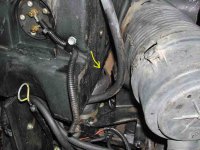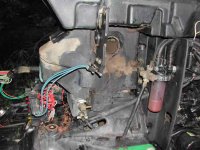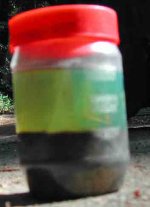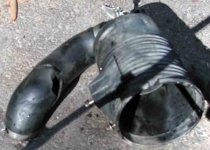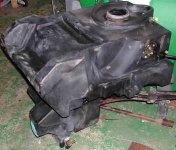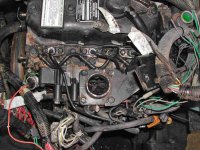dfkrug
Super Member
- Joined
- Feb 3, 2004
- Messages
- 7,177
- Location
- Santa Cruz Mtns, CA
- Tractor
- 05 Kioti CK30HST w/ Prairie Dog backhoe, XN08 mini-X
Once I got the loader off, I went thru a second session with the pressure
washer. I cleaned off buckets of dirt, while removing the few remaining
body panels, seat, floor boards, radiator, etc. (And that 100 lb nose
protector.)
And here is my "eureka moment". The report on this tractor was that it
ran, but very poorly, with lots of black smoke. The air filters were correct
and in place, so the cause of the engine failure was unknown. Until now.
The first photo shows a split in the air hose between the air filter housing
and the air intake mainifold. The culprit hose, which is open to dirt, is
pinched between the fuel tank and the valve cover. The split was invisible
until I cleaned things up and started to remove the bracket that holds the
filter housing.
Now I need to get the fuel tank out to get access to the valve cover and
the air intake manifold. I have never seen such a difficult to remove tank!
I had to remove the steering system support, PS hard lines, instrument
cluster, fuse panel, numerous brackets, and the 2-sided brake pedals. The
pedals pivot on a shaft that goes through the middle of the the fuel tank!
JD was willing to do ANYTHING to get 10 gallons of fuel in there it seems.
I give Deere a LOT of credit for putting a fuel drain in the tank. Every CUT
I have rebuilt has had sludge in the bottom of the tank, and this is the first
time I have had a drain petcock. The jar shows the last bits of liquid I
removed thru the drain. I had to blow into the drain a few times to get
the last to come out.
washer. I cleaned off buckets of dirt, while removing the few remaining
body panels, seat, floor boards, radiator, etc. (And that 100 lb nose
protector.)
And here is my "eureka moment". The report on this tractor was that it
ran, but very poorly, with lots of black smoke. The air filters were correct
and in place, so the cause of the engine failure was unknown. Until now.
The first photo shows a split in the air hose between the air filter housing
and the air intake mainifold. The culprit hose, which is open to dirt, is
pinched between the fuel tank and the valve cover. The split was invisible
until I cleaned things up and started to remove the bracket that holds the
filter housing.
Now I need to get the fuel tank out to get access to the valve cover and
the air intake manifold. I have never seen such a difficult to remove tank!
I had to remove the steering system support, PS hard lines, instrument
cluster, fuse panel, numerous brackets, and the 2-sided brake pedals. The
pedals pivot on a shaft that goes through the middle of the the fuel tank!
JD was willing to do ANYTHING to get 10 gallons of fuel in there it seems.
I give Deere a LOT of credit for putting a fuel drain in the tank. Every CUT
I have rebuilt has had sludge in the bottom of the tank, and this is the first
time I have had a drain petcock. The jar shows the last bits of liquid I
removed thru the drain. I had to blow into the drain a few times to get
the last to come out.
